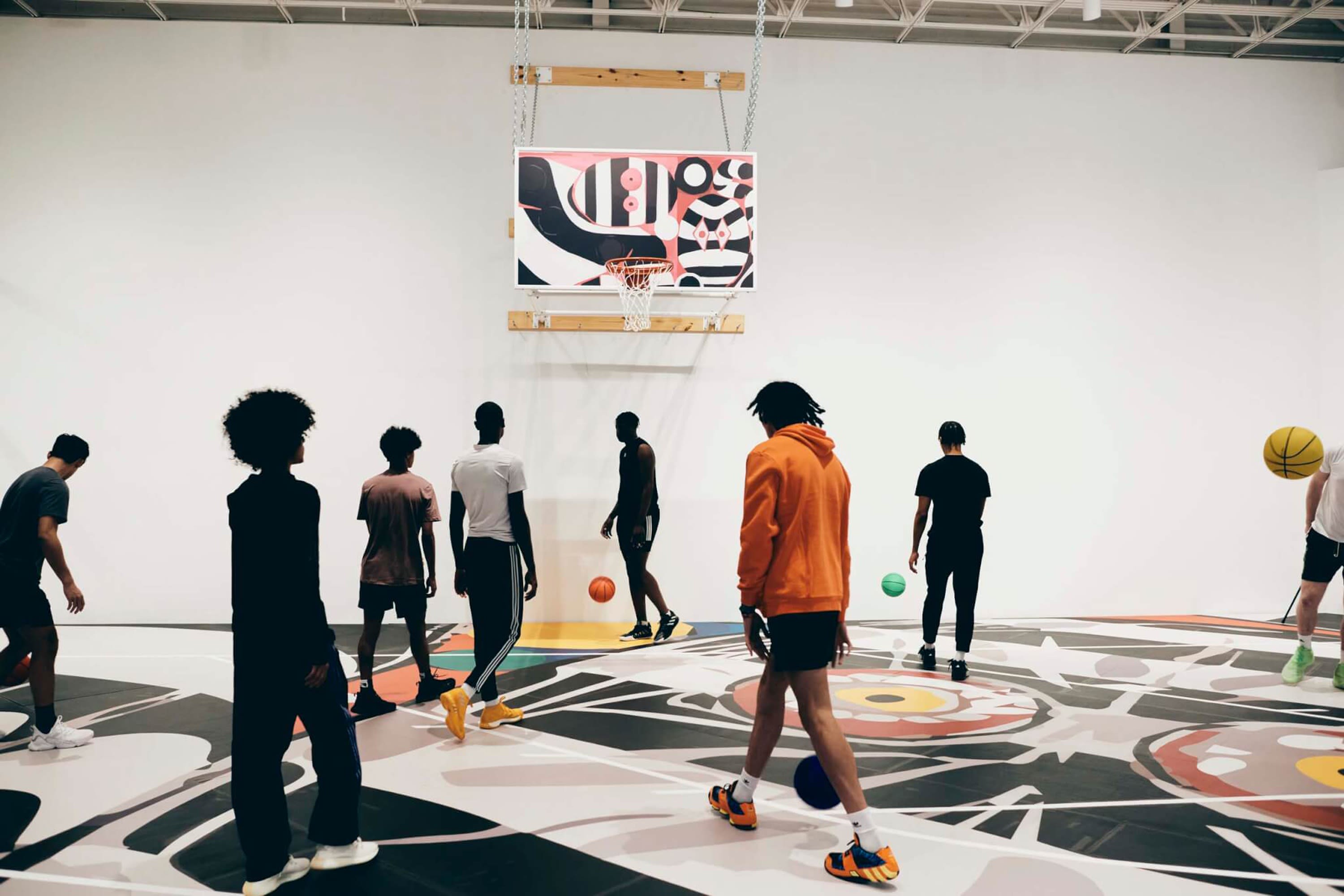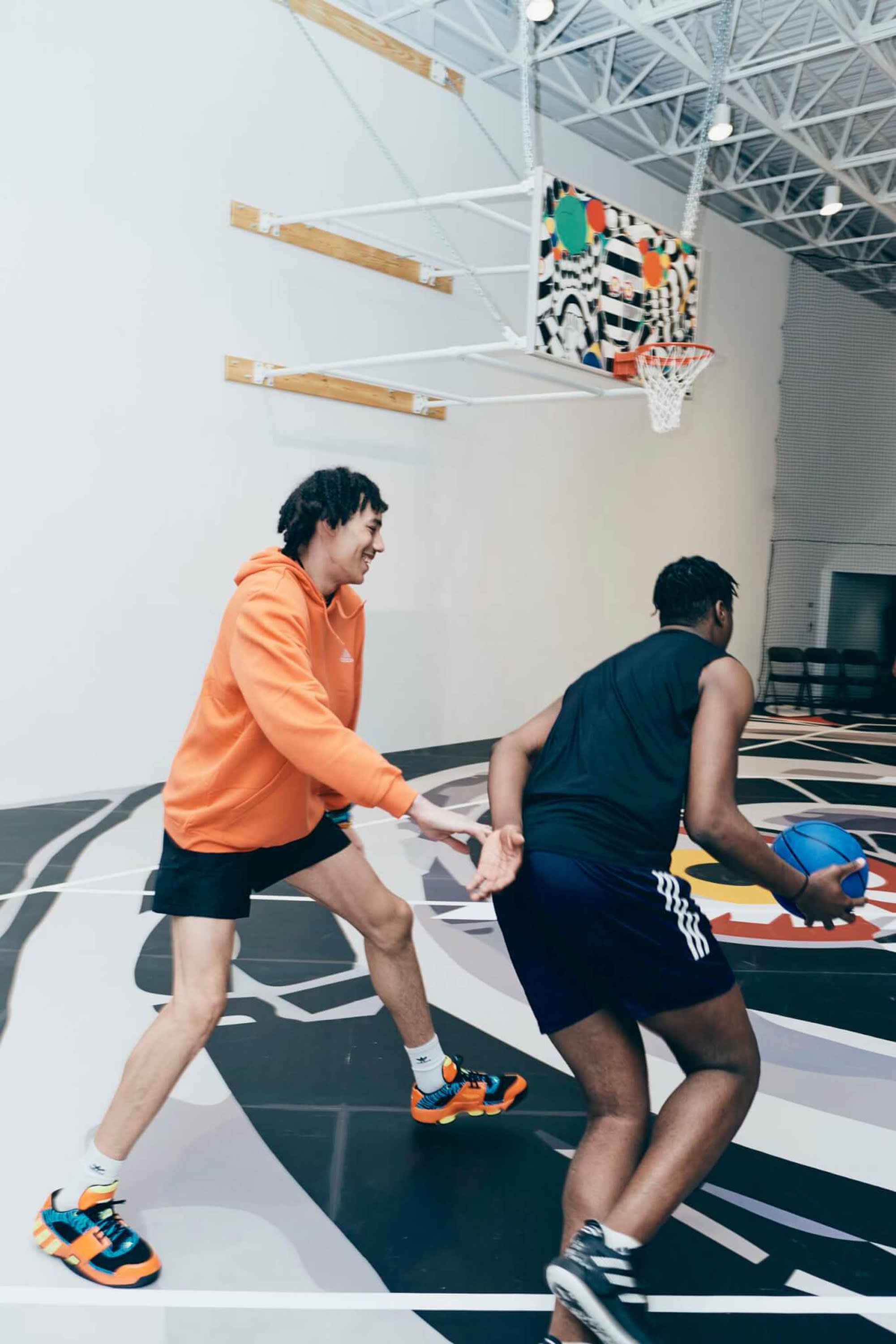CAMH COURT
Contemporary Arts Museum Houston
5216 Montrose Boulevard
Houston
Through April 27
In the early 1990s, Contemporary Arts Museum Houston’s (CAMH) museum registrar Tim Barkley threw around the idea to install a basketball in the museum. Three decades later the idea was realized with an installation of a basketball court by artist Trenton Doyle Hancock. “Since then, it has become something of a provocation among the staff,” CAMH director Hesse McGraw told AN. In-house graphic designer Phillip Pyle, II recently heard about this internal aspiration from his colleagues. After working on the museum on a collaboration with the Houston Rockets to create artist-designed posters of the team’s legendary players, he thought the court myth had to turn into reality.

Trenton Doyle Hancock, CAMH Court, 2023. Photo by Peter Molick.
“Trenton has been an important part of CAMH,” McGraw said about their immediate decision to tap the Houston-based artist who had the first institutional exhibition of his career at CAMH in 2001. Unlike its decades long imagining, the court was realized within two months, and CAMH COURT is currently open for museumgoers to score baskets on its three-hoop playground, including one for children. The installation opened on March 18, timed for Houston’s fourth time hosting NCAA Men’s Final Four, which took place between March 31 and April 4 at the NRG Stadium.
Hancock’s work spans painting, drawing, and sculptural installation. His signature motifs are inspired by myths, urban life, and Black experience. Through this work he decided to engage with the audience through a challenge. “The museum’s shape being a parallelogram, I wanted the players to realize something is different with this court in the way it conforms to the museum’s architecture,” he said about the dynamic installation.

PHOTO BY Gemicah Jones.
The artist dressed the court inside the Brown Foundation Gallery with his Bringback figures, mouthless minions with black and white stripes. “They are bringers of positive memories of the childhood—think Santa’s elves but demented versions,” Hancock offered. Their red and yellow eyeballs and black and white faces dress the court’s parquet maple wood flooring with a kaleidoscopic energy while the hoops’ backboards have more clear depictions of the figures’ comical likenesses.
The museum partnered with Adidas basketball and worked with sports production company Creative Sports Concepts to build what McGraw called, “a bespoke architecturally specific court.” A challenge of the installation was the gallery’s uneven floors. A suspended decking now levels the added wooden surface, which was painted by the artist. A vinyl surface printed with the image of a typical basketball court floor covers the children’s section.
A primary goal of Hancock was to prompt the players to position themselves on the court within the terms of his art. “The three-point lines are skewed or the half court is off, so they rather make associations based on where the eyeball is to shoot,” he explained. Hancock thinks as long as there are certain markers for how the game should be played, “a court can be many different things.”
 TRENTON DOYLE HANCOCK, CAMH COURT, 2023. PHOTO BY PETER MOLICK.
TRENTON DOYLE HANCOCK, CAMH COURT, 2023. PHOTO BY PETER MOLICK.
Artists have long engaged with spaces and rituals that are outside the typical architectural scope of an art institution. Pop artist Robert Indiana designed the floor at Milwaukee’s MECCA Arena in the late 1970s and, on the opposite end, conceptual artist Rirkrit Tiravanija is best known for his socially engaged practice of serving curry or tortilla soup inside the museums.
“This experience creates a meditation between what people consider intellectualized version of play and the dirty and sweaty version of actually playing,” Hancock explained. “Instead of a curated idea of community engagement which is already part of any institution’s programming, the museum here had to catch up with the community, as opposed to the other way around.”
The word-of-mouth expansion of this engagement, which has surpassed the limits of typical museum audience, delivers on the artist’s statement. In response, the museum has been activating the space with programming, including basketball clinics and youth workshop on April 16, and youth basketball and dance clinic with the Rockets on April 22.
Besides the designated events, the court is open to public to play with balls which were also designed by Hancock with a design using his Bringback folks. “The people complete the work,” the artist added. “If we step back and examine it objectively, we see there is nothing but smiles and happiness on the court which is a macro model of what can in larger scale allow people to interpret the space of a museum.”



